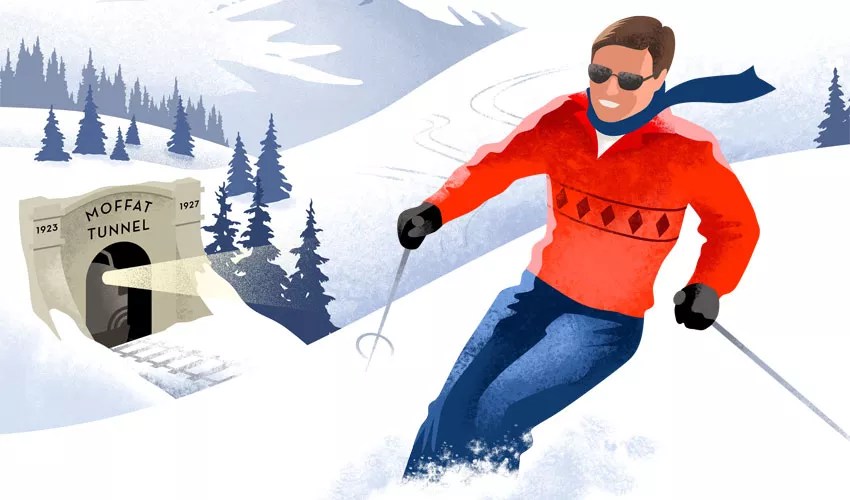
Michael Crampton

Audio By Carbonatix
In January, when train service between Denver and Winter Park resumed for the first time in seven years, employees of the resort were on hand to welcome the arriving passengers.
One greeter stood out from the rest. Lean, fit, soft-spoken, pushing seventy but looking fifteen years younger, he turned up weekend after weekend, standing on the heated platform as the Winter Park Express pulled in. He helped unload gear, answered questions about conditions and terrain, and directed newbies to the slopes, a few steps away. He could easily have been mistaken for some helpful docent type, a retiree with too much time on his hands. But those who caught a glimpse of his employee name tag knew better.
You’re Gary DeFrange, they said. You’re that guy. Thanks for bringing the train back.
DeFrange, the president of Winter Park Resort for the past twenty years, is the first to admit that getting the ski train on track again after an array of financial obstacles halted service in 2009 was a complicated and costly business, with many players involved. But his own persistence had a lot to do with it. His willingness to roll up his sleeves and get right into the fray has been a hallmark of his time at the resort – a hands-on, slopeside style of management that’s kept him in touch with all phases of the operation, from the quality of the powder at Parsenn Bowl to the reliability of the fireside fondue at the Lodge at Sunspot.
“Gary’s on that mountain every day,” says Dean Singleton, the former Denver Post chairman and MediaNews co-founder, who’s known DeFrange for decades and was serving on the resort’s governing board when it hired him. “He’s on the mountain when the lifts open, he’s there mid-day to make sure the lunch crowd is working okay, and he’s on the mountain at the end to do the sweep. He’s got his stamp all over that resort.”
Getting the train back was a priority for DeFrange. Even though many of the trips have sold out, the trains currently have a 540-passenger capacity, accounting for only a tiny fraction of the resort’s annual tally of a million or so skier days. But DeFrange regards the effort as “an incredibly good project” for several reasons.
“We estimate we’re taking 500 cars off I-70 every weekend,” he notes. “We’re using equipment that’s already there, and the locomotives they use today are very efficient. And we are the only major resort in the United States where you can fly into a world-class airport, take a train to downtown Denver and then a train here – without ever renting a car.”
There’s also a legacy issue bound up with the train and what it represents. Without the rail line that barrels through the Moffat Tunnel under the Continental Divide, Winter Park would never have evolved the way it did. The train is a clacking, whistling, rocking reminder of the resort’s historic ties to the City of Denver, which launched the ski area in 1940 as a rugged mountain park for the enjoyment of its citizens and still reaps millions of dollars a year from its current operator, Intrawest. Although there are a handful of other municipalities around the world that own a ski area, none of them can boast of an operation as substantial as this one – 26 lifts, 143 trails, 3,081 skiable acres – or a relationship as complex as the one Denver has had with Winter Park.
DeFrange announced his retirement a few weeks ago and will step down at the end of this month. He’s only the third boss Winter Park has had in the past 66 years, and his tenure has been fraught with challenges. When he took the helm two decades ago, the resort was sliding into a financially untenable situation, and consultants and task forces were urging city officials to sell the place and be done with it. DeFrange took Winter Park in a bold new direction, one that has salvaged the relationship with the city and greatly expanded its operations, added hundreds of units of lodging at the base of the mountain, upped its summer game, and transformed what was once a dowdy day-ski area into a full-service, year-round destination resort.
The experience may be a bit ritzier (and pricier) than it was in the old days, but Winter Park is still no Vail or Aspen – and that’s fine with DeFrange. In his youth, the Denver native was more comfortable with an accordion slung over his shoulder than a pair of skis. When he finally fell in love with Winter Park, it was the things that made it different from other ski resorts – the friendly staff and down-home atmosphere, the bumps on Mary Jane, the National Sports Center for the Disabled, the train, the local festivals and après-ski traditions – that kept him coming back, the same features he’s been keen on preserving throughout a difficult transition.
“Everybody wanted to make sure that we maintained the culture that Winter Park has,” he says. “I think we’ve managed to hold on to that.”
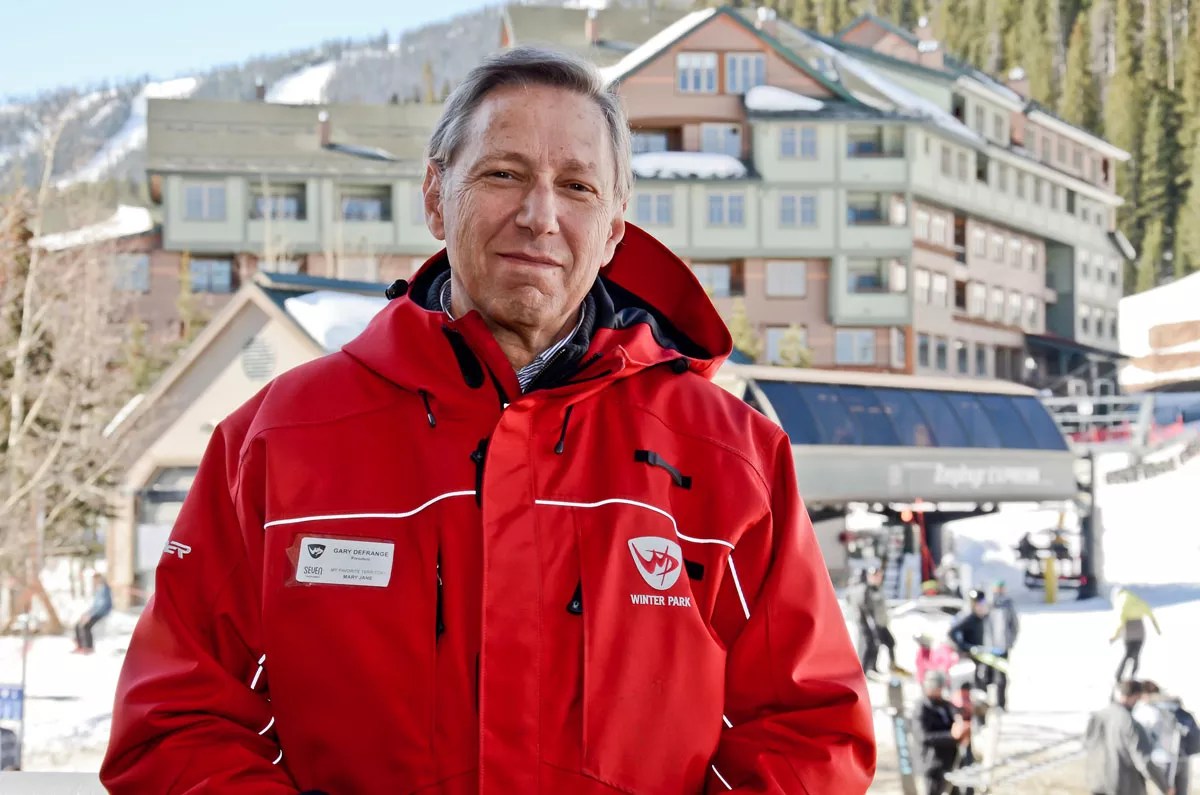
Gary DeFrange transformed Winter Park into a year-round destination resort.
Winter Park Resort
Winter Park first opened for business on January 28, 1940. The lift charge was one dollar, which entitled skiers to ride a 2,300-foot-long T-bar and a 2,700-foot-long rope tow up the mountain and ski down as many times as they liked. Despite the rustic accommodations – some warming sheds and outhouses and not much else – thousands of Denver residents showed up for the opening ceremonies, along with a host of local dignitaries.
Ralph Carr, then governor of Colorado, was there. So was Denver’s mayor, Ben Stapleton. But the real star of the show was Stapleton’s manager of Parks and Improvements for the city, George Ernest Cranmer, who’d been pursuing his own vision of a “Denver winter sports park” for years.
Cranmer was an odd duck in Stapleton’s administration, a patrician among ward-heelers, glad-handers and Klan sympathizers. He was a graduate of Denver’s East High and Princeton who’d made a bundle in the stock market and retired at the age of 44. He’d then turned to politics, becoming Stapleton’s campaign manager, which won him the slot as the parks boss. He was the point man for several of the most notable accomplishments of Stapleton’s five terms in office, including the creation of Red Rocks Amphitheatre, the Valley Highway and the expansion of Denver’s mountain-parks system.
When he was a young man, Cranmer had watched in amazement as Karl Howelson, a former circus performer known as the Flying Norwegian, improvised a ski jump on the lawn of the Colorado State Capitol, which was smothered in snow after the blizzard of ’13. Skiing wasn’t completely foreign to the state’s mining communities, which sometimes relied on crude Nordic equipment when other means of access to civilization were cut off. But for many years, the idea of skiing as recreation in Colorado was confined to a few hardy enthusiasts like Howelson, who helped organize ski-jumping exhibitions and winter carnivals in arcane locales such as Hot Sulphur Springs.
Cranmer hoped to make winter sports more accessible to the people of Denver. He was aided by the completion of the Moffat Tunnel in 1927, which provided easy passage by train under the Continental Divide at a time when the roads over it weren’t being plowed. In 1933 a group of diehard Denver skiers known as the Colorado Arlberg Club built a clubhouse near the tunnel’s West Portal (where Winter Park stands today) and began working on turning sheep trails on the nearby slopes into ski runs. Then U.S. 40 was paved and plowed, opening the way for Berthoud Pass to become the most heavily trafficked impromptu ski area in the state.
By the late 1930s, Cranmer was convinced that the time was ripe for a major leap forward. He persuaded the U.S. Forest Service to grant the City of Denver a special-use permit for 6,400 acres of terrain towering above the West Portal. He cut a deal with the Moffat Tunnel Commission to lease nine acres at the base of the mountain at no charge. He raised more than $14,000 for the lift equipment through “subscriptions” from local swells and businesses, such as the May Company and Denver Dry, and worked with the state’s congressional delegation to get grant funds from the federal Public Works Administration. And on opening day, he stood in front of the throng and rhapsodized about the future of skiing in Colorado.
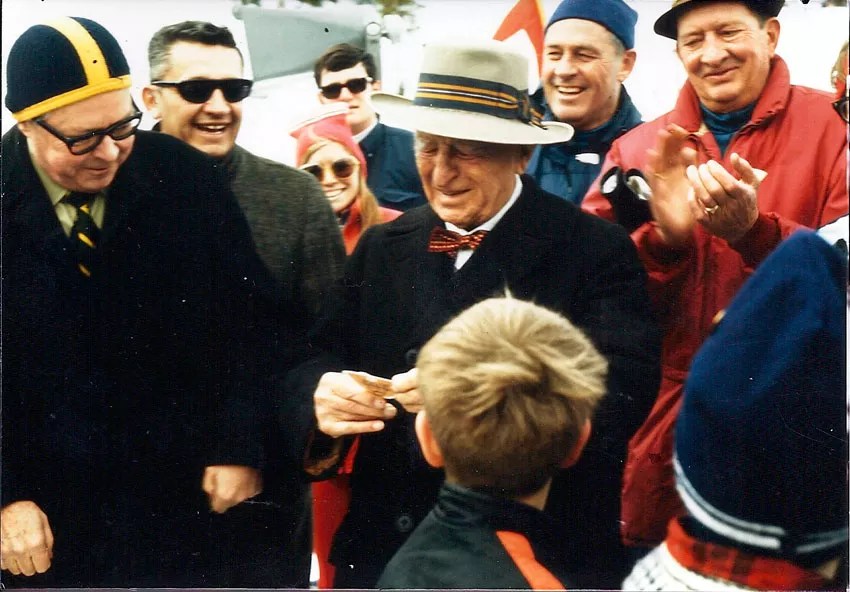
Winter Park’s founder, George Cranmer (wearing bowtie), was honored by Denver Mayor Bill McNichols, a clapping WPRA chairman Allan Phipps and others at Winter Park
Grand County Historical Association
“The beauty of the white snow, contrasted with the deep green of the forest, made brilliant and scintillating by our strong winter sun, is unsurpassed,” he declared. (A copy of the speech can be found in his papers at the Denver Public Library.) “Beautiful as these mountains are in summer, they are even more so in winter, and each time the sportsman reaches a high point, he is rewarded with a thrilling vista.”
Winter Park, Cranmer said, would be not just for locals, but for “the millions of Americans living in the flat country to the east to enjoy really good skiing…. Possibilities for future development are unlimited.” He talked about how important sport had been to the Greeks, the Romans – even to the hardy Finns, now using their winter survival skills in a desperate battle against Soviet invaders. He also talked about how skiing could benefit not only Denverites’ health, but the wallets of entrepreneurs: “The velocity of the dollar is increased greatly where sports are active.”
But in its original incarnation, Winter Park failed to have the kind of economic velocity Cranmer had predicted. The lift equipment had cost more than anticipated, leaving no funds available for building trails and other amenities; Cranmer had to tap into the mountain-parks budget and dispatch “volunteers” from the city parks department to get the slopes ready for business. The tows broke down frequently and had to be replaced, piece by piece. At the end of the first full season, the ski area had drawn around 11,000 skiers but was running $15,000 in the red. Cranmer wrote the captains of industry who had taken out subscriptions, on the promise of repayment, and asked them to forgive the debt. “With a meager amount of funds, a small beginning has been made in the development of winter sports in Colorado,” he reported to the Denver Chamber of Commerce.
Winter Park continued to struggle through the war years that followed; skiers determined to visit the place had to deal with a rubber shortage and then a coal strike that temporarily sidelined the ski train. Cranmer continued to push for better facilities and more trails, but the project received only driblets of money from begrudging city officials, who didn’t see much point in raiding municipal coffers to prop up a “sports park” seventy miles away. (Over the first 75 years of Winter Park’s existence, Denver invested a grand total of less than $300,000 in the operation.) Meanwhile, better-designed tows and T-bars began to spring up at other fledgling ski areas, including Arapahoe Basin, Berthoud Pass, Snow King Valley (near Hot Sulphur Springs), Loveland Basin, Monarch Pass and Aspen.
The lack of city support outraged several prominent members of the Arlberg Club, who’d dug into their own pockets to help launch Winter Park. In 1947, around the time that Stapleton and Cranmer were leaving office, they came up with a plan to save the ski area from Denver’s tightwads: form a nonprofit to run the resort. A nonprofit could raise money without putting the city into debt; it could reinvest any profits in upgrading the facility without fear of having its funds raided by the city; it could hire employees and make purchases without following increasingly cumbersome city regulations; and, if business was exceptionally good, it could even make some payments back to the city.
Created in 1950, the Winter Park Recreational Association hustled to make the resort viable in the increasingly crowded post-war ski industry. Under the direction of its first chairman, Allan Phipps – Arlberg member, Oxford scholar and later a co-owner of the Denver Broncos – the all-volunteer board launched a capital campaign that gave the place much-needed new lifts and trails. The ski area’s new executive director, Steve Bradley, brought in a host of innovations as well, including a professional ski patrol, a ski school and the Bradley Packer – a gravity-driven grader, piloted by a single skier, that pioneered the art of snow grooming.

Ski patrollers grooming the Bridge Trail with Bradley Packers in the early 1950s.
Grand County Historical Association
Soon on solid financial ground, Winter Park became the place where generations of Denver residents came, by train or bus or car, to learn how to ski. (It helped that one of the provisions of the WPRA’s original contract with the city required that lift tickets be priced “at the lowest reasonable cost.”) But a growing and increasingly sophisticated clientele also demanded making constant upgrades, opening new and more challenging terrain, and finding other ways to keep skiers coming back.
Phipps understood this, adding chair lifts, restaurants and other attractions as business swelled. But the most dramatic improvement came after Phipps stepped down from the WPRA in 1970. The new board president, Jerry Groswold, embarked on a six-year gauntlet of permits and construction headaches that led to the opening of the Mary Jane ski area, which nearly doubled the skiable acreage of the resort. The addition also gave mogul-happy masochists a new mantra: No Pain, No Jane.
Mary Jane and subsequent developments significantly boosted the resort’s revenues, but little of that cash found its way back to the City of Denver. Some went to debt service and resort operations; some went to purchasing land around the base of the mountain from the Moffat Tunnel Commission, from the city itself, or from the Forest Service through land swaps. By the early 1990s, the WPRA was feeling sufficiently bullish about the resort’s prospects to approach city officials with a plan to buy the asset from the city for $53 million, in payments spread out over sixteen years.
Denver Mayor Wellington Webb outlined the plan, presenting it as an all-but-done deal, at his 1993 State of the City address. The proceeds, he said, would fund new parks in the city. Mass confusion ensued. Many Denver residents were unaware that the city owned Winter Park, but once they found out, they were opposed to selling it.
The Rocky Mountain News editorialized in favor of the deal, calling the arguments against it “sentimental rubbish.” The Denver Post weighed in against the sale, pointing out that the resort was more than $20 million in debt and had other endowment obligations, meaning that the city would only collect about half of the sale price. “It looked to us like the price was too cheap, the terms were too good, and it looked like an insider deal,” Singleton recalls. “It didn’t look or smell good.”
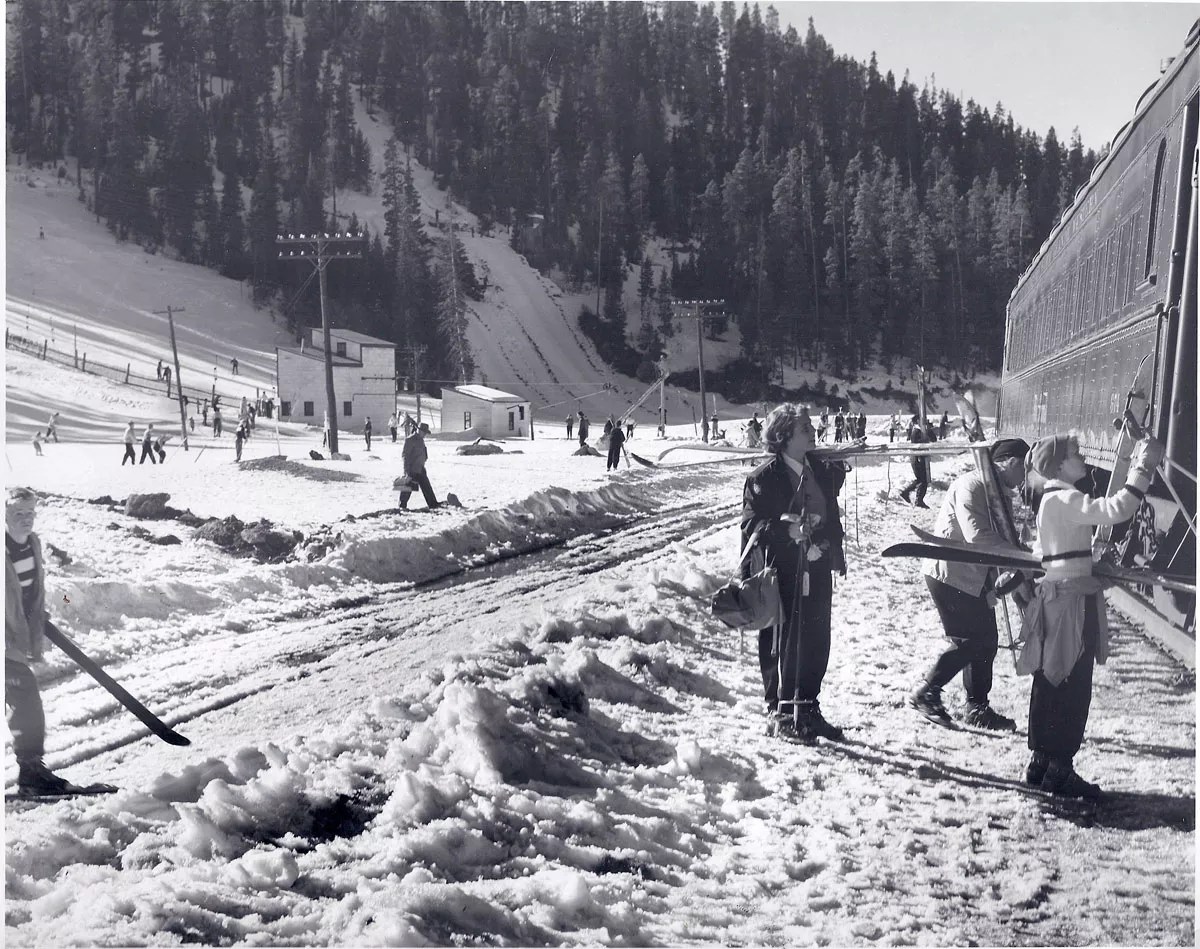
The ski train from Denver provided slopeside access to Winter Park from its earliest days until 2009.
Grand County Historical Association
Stung by press criticism and opposition from city council members, Webb did an about-face: Winter Park wasn’t going to be sold on his watch. Instead, the city renegotiated its arrangement with the WPRA, which hadn’t provided much revenue to Denver for years. Under the new terms, the city would receive annual payments of $2 million, earmarked for Denver Department of Parks and Recreation capital projects. In return, the WPRA got the right to sell property at the base of the mountain to private developers.
To some observers, the new deal was an indication of just how little control Denver still exercised over the resort. Although the city had never formally sold the resort itself, it had given up tracts of land and authority over the operation bit by bit, prompting Rocky reporter Kevin Flynn (now a Denver City Council member) to refer to the WPRA as “the private nonprofit corporation that owns Winter Park Ski Area.”
Strictly speaking, the ownership is more layered than most people realize. Most of the ski area’s acreage is still Forest Service land, operated under a special-use permit. The rest is in the hands of the WPRA, which acts as the city’s agent, but the nonprofit can’t turn around and sell the resort without city approval.
“It’s a distinction not many people comprehend well,” says Liz Orr, a former Webb staffer and current administrator of the WPRA. “The city has a residual interest in the resort. The resort is actually owned by the WPRA. But the city can dissolve the WPRA and would own all the assets.”
WPRA’s effort to buy Winter Park came at a time when the ski industry was changing rapidly. Many of the state’s most popular ski areas were being gobbled up by major corporations; Keystone and Breckenridge, for example, had been purchased by Ralston Purina and would soon be acquired by Vail Resorts, which also operated Beaver Creek. The consolidation allowed the big companies to offer discounted multi-resort packages and target destination skiers who might book several days for a ski vacation, spending exponentially more than a day skier would. To compete for the much-prized destination skiers, a company had to invest millions in lodging and off-slope attractions. But Winter Park was still stuck in the day-skier business, with no access to the kind of funds it needed to get into the real-estate game.
After he joined the board in 1996, Singleton began to appreciate why the WPRA was so eager to win the right to sell property for development. “Winter Park owned a lot of land at the base of the mountain, but it didn’t have capital to develop it,” he says. “We were in a vise we couldn’t get out of. We couldn’t develop condos for that revenue stream, and we were in a price battle for season tickets with other resorts, which had other sources of revenue. They were using profits from condo development to buy more equipment, and we were having trouble generating cash to put into the ski mountain.”
The problem, as WPRA president Groswold liked to put it, was that Winter Park “didn’t have enough pillows.” But figuring out how to get more pillows on the mountain without selling the place outright was a tricky business – particularly when Denver was now tapping the operation for $2 million in tribute a year. At one point, city officials kicked around the idea of selling bonds to promote development at the resort.
“The mayor considered doing a bond issue,” Singleton recalls, “but then decided that going to the voters to ask for money to build condos at Winter Park might not go over very well.”
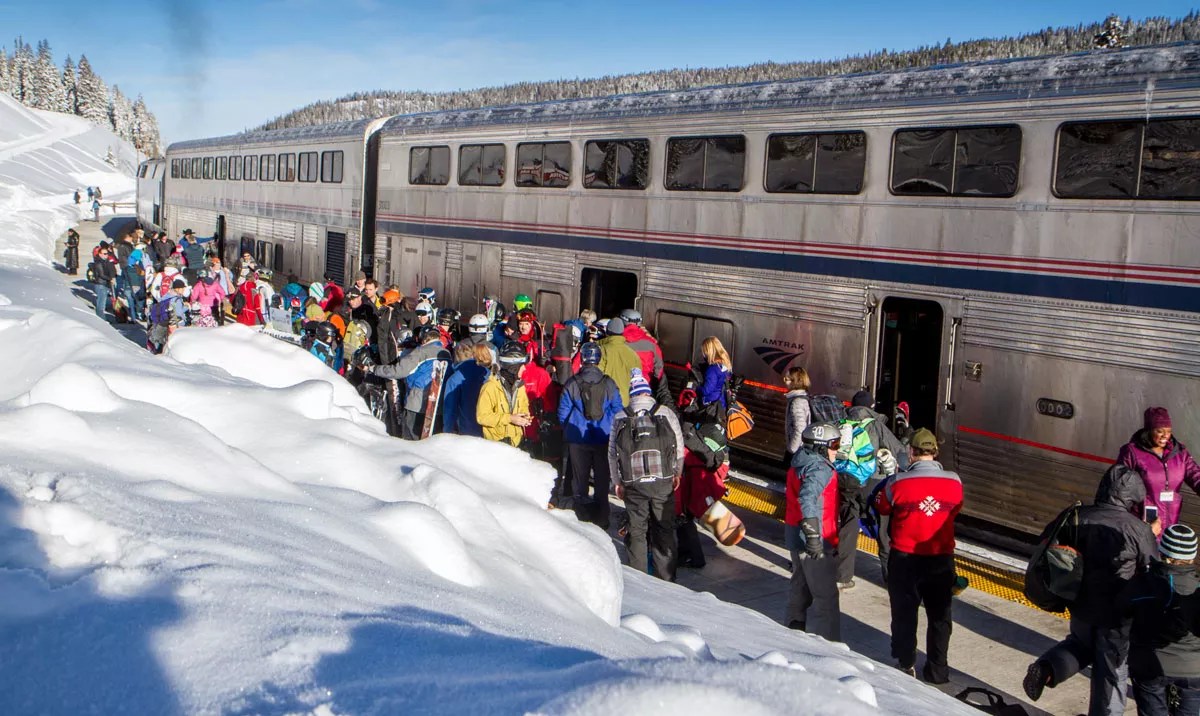
Amtrak started providing service to Winter Park this past January and quickly sold out most weekends.
Charles Stemen / Winter Park Resort
Gary DeFrange took charge of Winter Park in the summer of 1997, shortly after Jerry Groswold announced his retirement. At first glance, DeFrange seemed to be a strange choice, a break with precedent. He wasn’t a member of the WPRA board. He had no real background in the ski industry. But he knew finance, and he knew Winter Park. Most important, a lot of people associated with Winter Park knew him and believed that he could guide the resort out of its cash-flow crisis.
“We were looking for a businessman,” Singleton says. “Jerry was a good businessman, too, but Jerry had come up the ski side. We went for a businessman who also happened to know the mountain backward and forward.”
DeFrange grew up in north Denver and went to Regis High School. Both of his parents were musicians; they were not skiers. His father had his own accordion studio and played in a band at the Aviation Country Club in Lakewood. Young Gary started taking lessons on the squeezebox at the age of five. “There was absolutely no choice about that,” he says now. “But when my dad started teaching me music theory at the age of sixteen, it really clicked with me. I started a swing band, the Gary DeFrange Combo, and I had that band for twenty years.”
During the summers he worked at a cousin’s truck farm at 64th and Pecos, tending to cherry peppers destined for the Kuner’s canning plant. DeFrange considered himself more of a farm boy than a city kid and kept working there even after he started college, majoring in business at the University of Colorado. After graduation, he landed a job as a management trainee at the First National Bank of Denver, then the largest bank in town. He rose rapidly, working in various departments. By the age of 27, he was an assistant vice president, and his boss invited him to take ski lessons with him at Geneva Basin.
DeFrange accepted, even though his only previous encounters with the sport had been exercises in misery. In high school, he and a buddy had gone to Winter Park, untutored and clueless. They had skipped the lift line, sidestepped their way up the Parkway trail, then slid down; by the end of the day, DeFrange had developed an enormous blister on the side of his foot. A night trip to Eldora had also been a cringe-worthy mix of horror and comedy.
Taking lessons, though, was like learning music theory. A few miscues, and then everything clicked. “I absolutely loved it,” DeFrange says. “I had a really good instructor, and at the end of five lessons, I had learned to ski fairly well.”
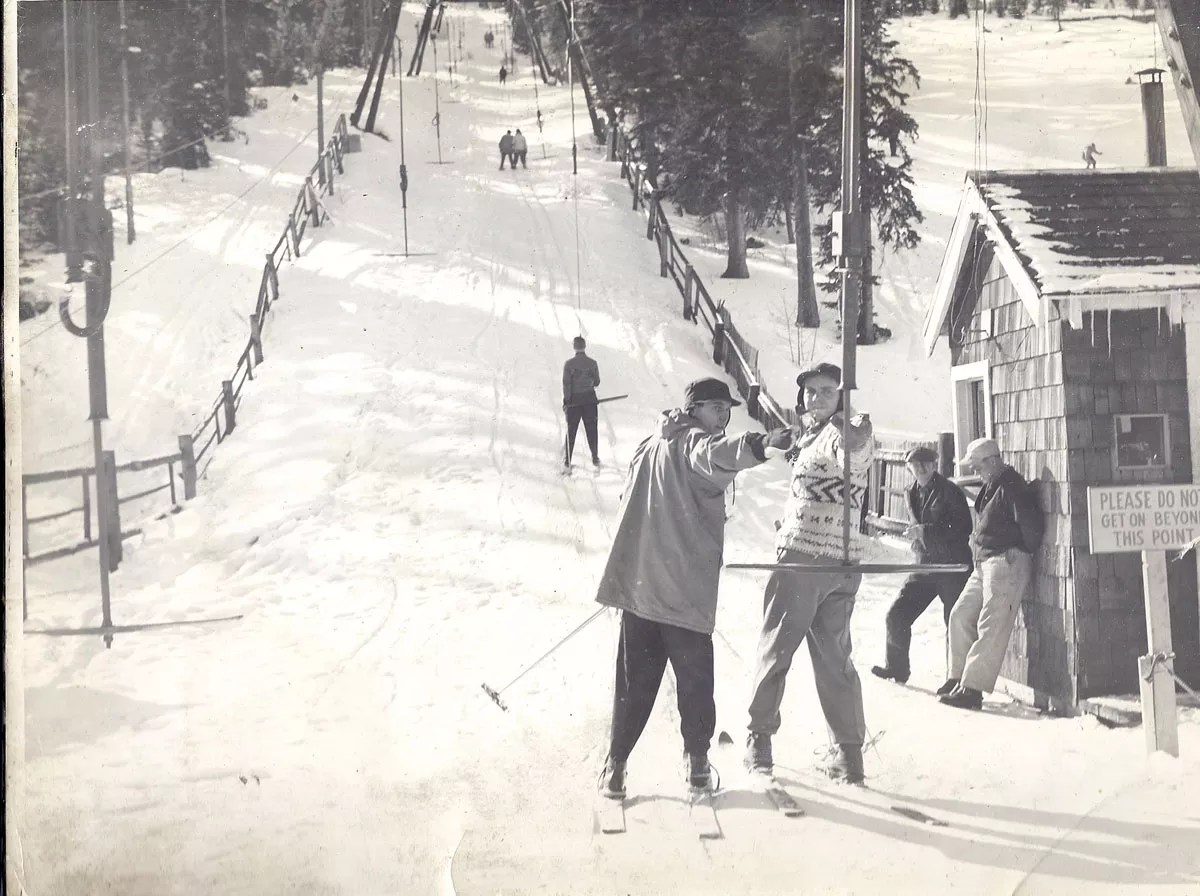
Skiers mounting the Hughes T-bar in the 1950s.
Grand County Historical Association
Before long, DeFrange was making regular assaults on the moguls of Mary Jane. His sister told him about a program at Winter Park that taught people with disabilities to ski, a program that would eventually evolve into the National Sports Center for the Disabled. As a rising bank exec, DeFrange had served on a number of do-gooder boards, usually as the treasurer, but he longed to do something that had a more direct impact than sitting around a conference table talking about fundraising strategies.
“I wanted to do something where I didn’t sit on a board, didn’t raise money, but actually saw results,” he says. “And I loved to ski. I thought that maybe I could teach other people how to ski.”
After undergoing training, DeFrange became a guide for blind skiers at Winter Park. He would stand with his companion at the top of the hill, describe the snow conditions, the size of the crowd and the general pattern of the run, then lead the way down, calling the turns as he went. “It really helped my communication skills,” DeFrange says. “It makes you be very organized in your thought process, very precise. You can’t skip words and you can’t skip thoughts.”
One of the skiers DeFrange met through the program was Nancy Stevens, who later became a U.S. Paralympic cross-country competitor and, in 2012, the first blind woman to summit the Grand Teton. The two skied together for years and have reconnected whenever Stevens returns to Winter Park. “She was just an incredible athlete, incredible balance,” DeFrange says. “The communication between us was terrific. We got to the point where, if the conditions were good, I would just say, ‘You drive,’ and I would follow her down.”
“Gary’s on that mountain every day. He’s got his stamp all over that resort.”
For several years, DeFrange kept to a schedule that would have buried a less energetic, less organized man. The Gary DeFrange Combo might have a Friday night gig at the VFW, after which DeFrange would haul his gear home and unload his truck, only to rise early on Saturday and hit the slopes. Saturday night might be another booking for the combo, followed by a Sunday morning trip to Winter Park to ski with the disabled. Then he would be back at the bank Monday morning.
In 1990 he was named CEO of First Interstate Bank of Denver; he was also the company’s regional head, overseeing operations in three states. His volunteer work led him to the board and then the chairmanship of the National Sports Center for the Disabled, which brought him into frequent contact with WPRA boardmembers and staff at Winter Park. Although he left First Interstate a few years later for the opportunity to own and operate an independent bank in Greeley, he’d made a strong impression on many Winter Park boosters. When Groswold announced that he was leaving, members of the WPRA board approached DeFrange to ask if he’d consider taking over.
In the course of his banking career, DeFrange had learned that there were several types of businesses that were risky loan prospects. You had to be careful if the business was too capital-intensive or labor-intensive. If it was dependent on the weather, such as agriculture, that was also a problem. So were seasonal operations. Winter Park fit all four risk categories. But to DeFrange, the resort’s financial issues presented a challenge too good to pass up, like an ice-crusted double-diamond run on a subzero morning.
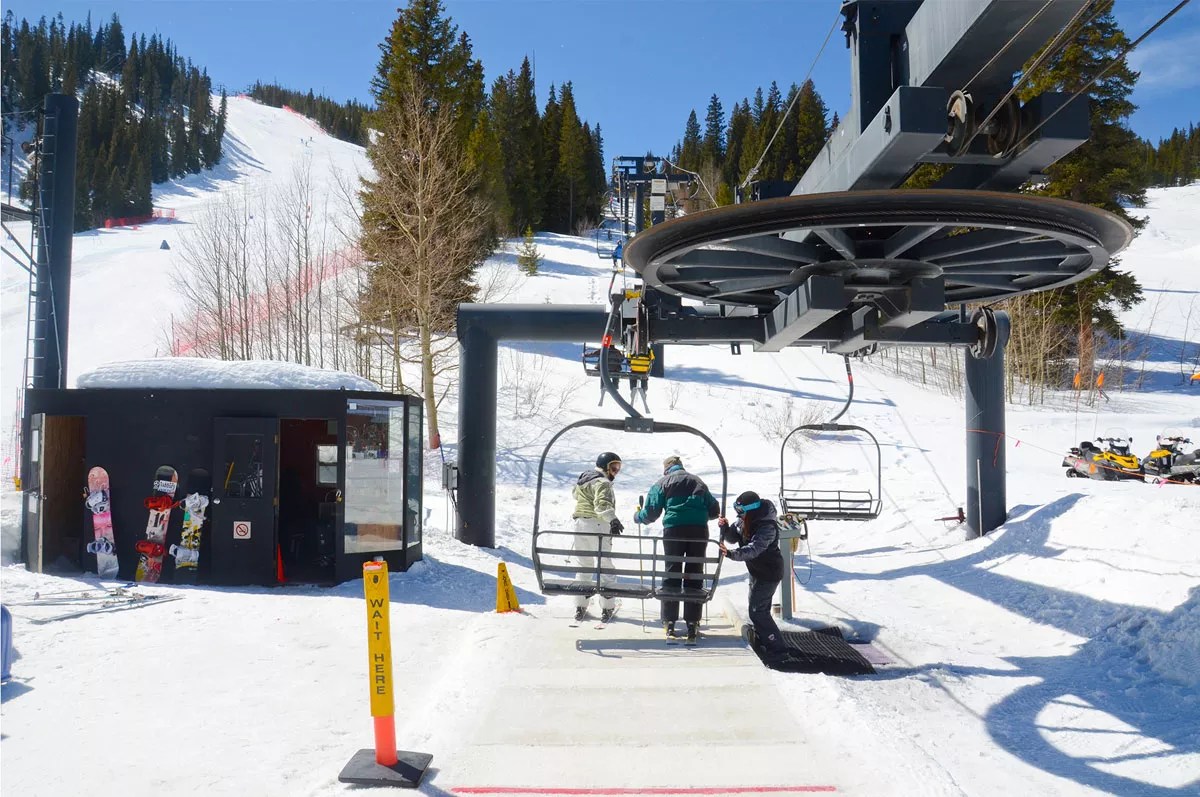
Today
Winter Park Resort
One of his first moves was to green-light a project that had been in negotiation for some time – the sale of property at the resort base to Hines, which proceeded to build the Zephyr Mountain Lodge, a mixed-use development with 230 condos and 27,000 square feet of retail space. Along with the Vintage Hotel, which was then owned by a Utah company, the Zephyr gave the resort genuine ski-in, ski-out lodging, some of the badly needed pillows Groswold had talked about. But it wasn’t enough.
“It became clear to me that unless the city was going to put money into this resort and not take money out, we couldn’t compete,” DeFrange says. “High-speed lifts were expected, and we had buildings that needed to be remodeled.”
The WPRA’s agreement with the city allowed it to opt out of the $2 million annual payments in years of bad snow conditions or other economic setbacks. DeFrange brought some spreadsheets to a meeting with Mayor Webb and informed him that Winter Park would be missing its payment that year. “He was not happy about that,” DeFrange recalls. “I really like Wellington Webb. He was a tough guy, but he was a good businessman. He said he understood, but he expected next year to get the payment.”
The new president worked with resort staff to try to squeeze more dollars out of the operation. He credits a marketing director with coming up with a “Friends and Family Fourpack” deal on season passes; at a time when Winter Park was charging around $700 for a single-season pass, bargain hunters could pool their resources and pick up four passes for a total of $800. The deal was widely imitated, and DeFrange was hailed as a marketing genius for pushing discounted season passes in the spring for the following season – now a customary practice throughout the industry. But he says there was a more compelling reason for selling passes early.
“We needed the cash,” he says. “I was worried about getting through the summer and not having enough cash to pay everybody.”
At his next meeting with Mayor Webb, DeFrange announced that the WPRA board had reached some sobering conclusions. “I said, ‘If you want to keep Winter Park, you need to quit taking money from us and you need to invest. Or you need to sell it. And by the way, we’re not going to be making any more $2 million payments.'”
Webb appointed a 25-person committee to study the resort’s operations and come up with a solution. Most of them favored the idea of selling the resort, but polls indicated that most Denver residents still opposed a sale, even if they’d never skied there. And there were other problems with the idea of a sale. Although Winter Park had never been formally dedicated as parkland and the actual property deeds resided with the WPRA, the city had always regarded it as part of the mountain parks system – none of which could be sold without a vote of the people. And Webb had already made it clear, during the earlier debacle over the proposed sale to the WPRA, that he wasn’t going to be the mayor who sold off such a formidable asset.
Webb favored a third option: finding a corporate partner to team with the WPRA to operate the resort. In early 2000, Denver’s battle-fatigued daily newspapers had announced plans to enter into a Joint Operating Agreement, and Webb wondered if something similar could be done for Winter Park. He summoned Singleton, the architect of the JOA, to explore the matter further.
“I remember sitting in the mayor’s office with a yellow pad, just the two of us, trying to decide what to do,” Singleton says. “We sat down and wrote who the likely partner would be, what the likely economics of the deal would look like – and two years later, that’s exactly who the partner was and exactly what the economics looked like.”
DeFrange remembers hiring an investment banker and trying to figure out how to structure a public-private partnership that could weave through the dense thicket of the much-modified compact between the city and the WPRA. Requests for proposals resulted in a field of six finalists, then two, then one favored candidate, the same name scribbled on Singleton’s pad months earlier: Intrawest, at the time the largest ski-resort operator in the world, whose holdings included the massive Whistler-Blackcomb resort and Colorado’s own Copper Mountain. (Although it would later sell Copper and several of its other operations, the company now owns Steamboat Ski Resort, too.)
Intrawest had the kind of savvy and access to capital to compete with heavyweights like Vail on an international scale. The company proposed to lease the ski operation from the WPRA, commit to investing $50 million in the mountain in the first ten years, and pay rent to the city (the “third party beneficiary” of the arrangement), amounting to about $2 million a year in the first decade, plus a $3 million payment up front. Intrawest would also have the right to buy land from the WPRA and develop it, providing the infusion of real-estate revenue that had long eluded the resort. No longer directly involved in operations, the WPRA would be restructured as a five-person board appointed by the mayor, charged with making sure that Intrawest met its obligations under the lease.
It was a complicated deal, one that took nearly a year to hammer out. “I felt pretty certain that once the deal was done, I was out of a job,” DeFrange says.
But late in 2002, as the terms were being finalized, DeFrange got a call from an Intrawest executive, who apologized for not getting in touch with him sooner.
“We just assumed you came with the deal,” the man said. “We want you to stay.”
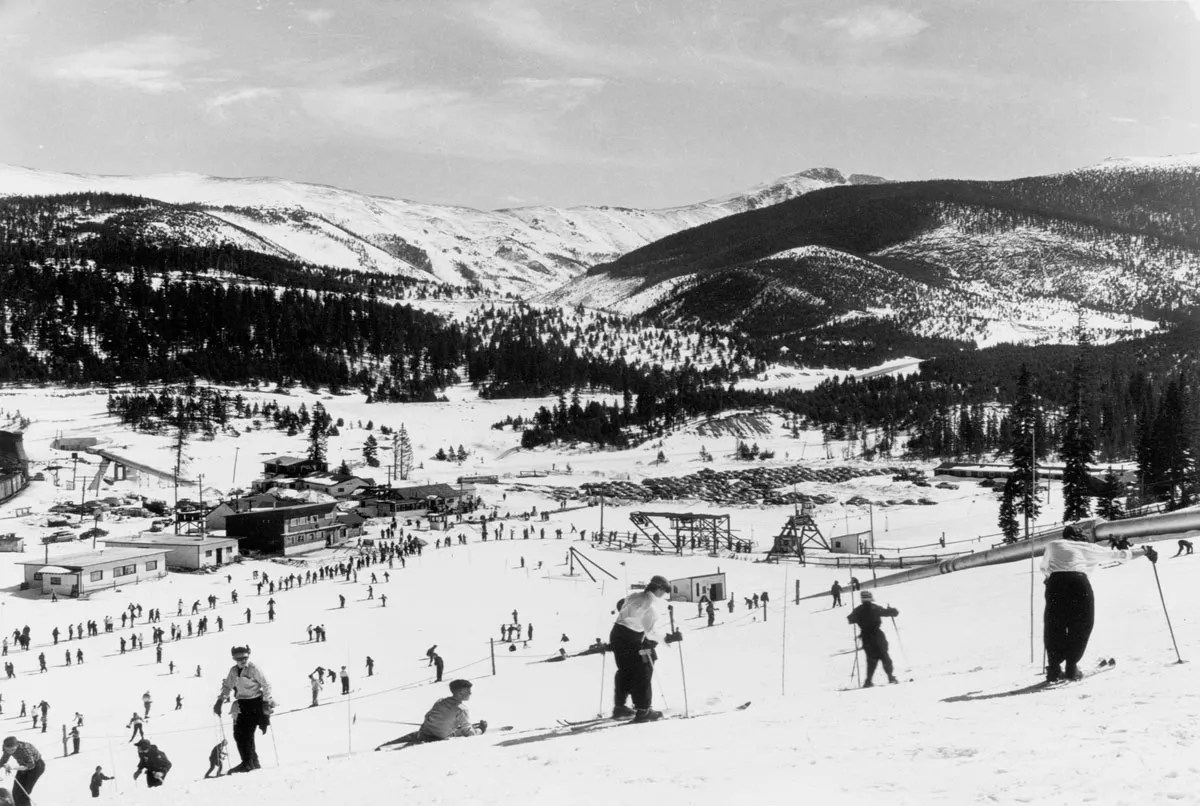
For decades, Winter Park was where Denver residents learned to ski, but the operation suffered from
Grand County Historical Association
Over the past fourteen years, Intrawest has spent freely but shrewdly on Winter Park, greatly increasing what the resort has to offer. The construction of several new high-speed lifts, such as the six-passenger Super Gauge and the Panoramic Express, has increased uphill capacity to 38,000 skiers an hour, with many of them headed to recently opened areas of the mountain – the expanded Parsenn Bowl, glade skiing at Eagle Wind, ungroomed backcountry double-diamond runs on the Cirque.
Winter Park was one of the first ski areas to embrace snowboarders, at a time when more hidebound resorts were shunning them. Now the place has six terrain parks for boarders of varying degrees of ability and an eighteen-foot-deep superpipe. In all, the resort claims seven different ski-related “territories” on its acreage, encompassing a wide range of activities one might want to engage in on a winter vacation high in the Rockies – including eating. A modest diner on top of Mary Jane has been replaced with the 16,000-square foot, $8.5 million Lunch Rock Restaurant, named after an outcropping where Arlberg Club members used to wolf down ham sandwiches. The fare at Lunch Rock leans more toward turkey-confit pie and craft beer.
The resort has also boosted its summer attractions well beyond the obligatory alpine slide and lift trips to the top of the mountain. Winter Park’s Trestle Bike Park, which caters to downhill rather than cross-country mountain biking, encompasses forty miles of trails. “We are now the largest downhill bike park in the United States,” DeFrange notes, “and we have approval for another ten miles.”
“With a meager amount of funds, a small beginning has been made in the development of winter sports in Colorado.”
Perhaps the most dramatic changes, though, have occurred at the base of the mountain, where Intrawest has developed an entire village of retail, restaurants and condos around the Zephyr Lodge and the Vintage Hotel. The resort now has 550 lodging units at the base, with raw land available for many more. Many of the units are more cozy than grandiose, but they come with an added benefit to Denver residents who may never venture into the village at all: The real-estate development has fueled the payments Intrawest has made to the city over the years, including a $3.5 million payment last year.
Since Intrawest took over resort operations fourteen years ago, those funds have helped pay for dozens of improvements, repairs and renovations at Denver parks and playgrounds, from major trail enhancements along the South Platte River and the revitalization of Ruby Hill to restoring the electric fountain at City Park and replacing bathrooms in mountain parks. Winter Park also provides snowmaking and staff support for the Ruby Hill Rail Yard, “a free urban terrain park” available to city skiers and snowboarders alike.
DeFrange believes the village has worked out well, meeting the shifting demands of the resort’s clientele. People don’t just expect to ski at a big ski resort any more; they need other stuff to do. “When I started skiing, you’d ski from eight-thirty until four and get ten or twelve runs in,” he says. “Today you get that many before noon.”
The WPRA’s Orr remembers that some boardmembers had great trepidation about developing the base village. “The one thing everyone agreed on is that they didn’t want another Vail,” she says. “They didn’t want a high-end, ritzy development. But I think they’ve done a remarkable job of keeping the character of the resort. And I give Gary a lot of credit for that.”
The village was also a concern for business owners in the towns of Winter Park and Fraser, who feared that Intrawest would work hard to keep skiers on the mountain, hurting motels and restaurants a few miles down the road. But the budget-minded still find their way to bars and burger joints outside the resort, thanks in part to a free shuttle service largely bankrolled by the towns. Winter Park remains a prime economic driver for the rest of Grand County.
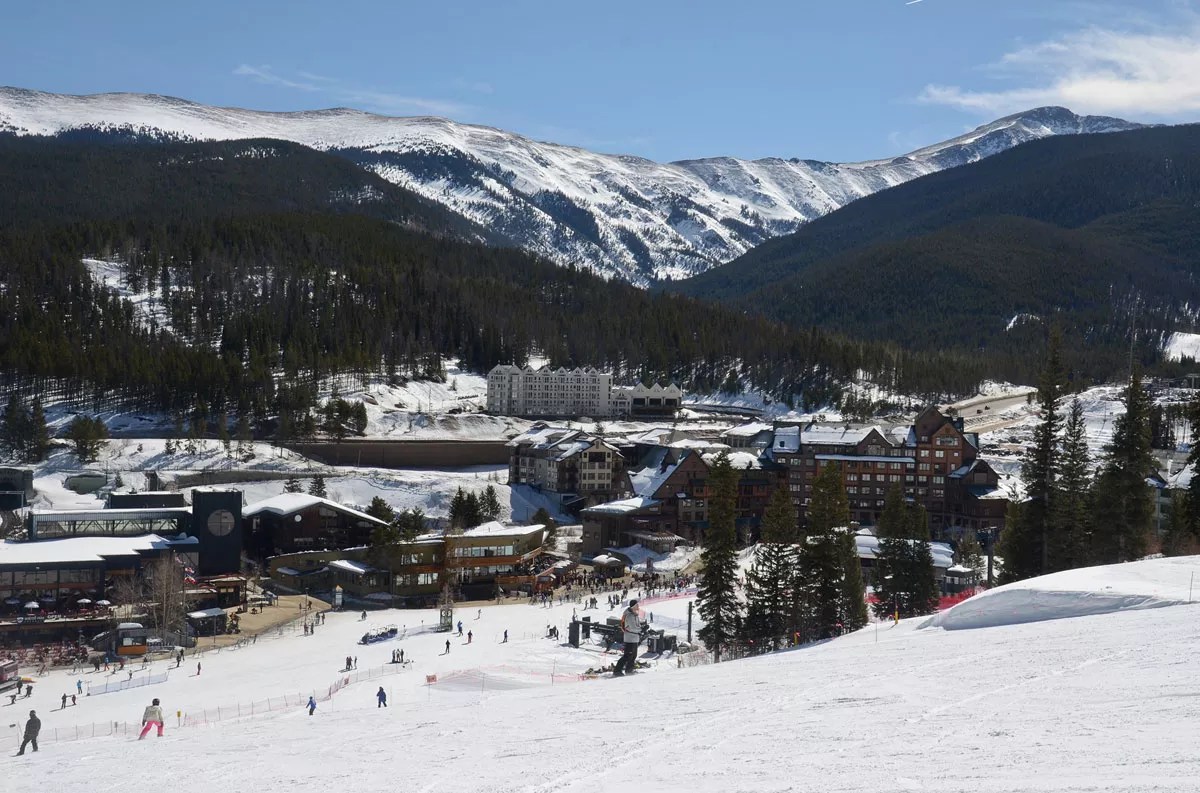
In recent years, the resort has developed hundreds of lodging units, along with new restaurants and retail, at the base of the mountain.
Winter Park Resort
“Any business they can bring into town is good business,” says Fraser Mayor Phil Vandernail. “We all rise together. The village is kind of its own entity, but people still come down to Fraser and shop. We have the only grocery store, the only movie theater.”
Former state legislator and longtime Winter Park businessman Al White also welcomed the new development. “I was excited about it,” he says. “We needed to attract the more affluent destination skiers, and the absence of a base village was hampering that.”
White first came to Winter Park in 1972. He ran ski shops and a small lodge there for decades. “We didn’t have a corporate culture back then,” he recalls. “It was just a bunch of people who wanted to move to Winter Park to be ski bums and make enough money to buy a season pass and a beer. In the summertime, dogs would sleep in the middle of Highway 40.”
But White doesn’t miss those days: “We may have lost some of that hippie-ish allure, but what we’ve gained is far more than we have lost – and there’s still an element of independence,” he explains. “We’re not Aspen, we’re not Beaver Creek, and we don’t strive to be that. We’re somewhere between Steamboat and Crested Butte on the vibe chart.”
One thing that Winter Park lost, then gained back, is the train. For many years, the ski train was subsidized by billionaire Phil Anschutz’s Ansco Investment Company, which purchased the Denver & Rio Grande Western Railroad in 1984. But rising insurance rates, scheduling conflicts with freight traffic and other problems finally prompted Ansco to pull the plug in 2009. Reviving the service involved considerable intrigue, expense, patience and dickering with a hydra-headed beast known as Amtrak.
DeFrange had made several attempts to get something going, including meeting with a private company that operated train excursions. But the insurance issues were formidable, and so were the number of players involved. Union Pacific owned the tracks, except for the portion that Burlington Northern claimed. Denver’s Union Station was under RTD’s control, but not the siding where certain passenger trains were parked.
After months of getting nowhere, DeFrange got a call from someone looking for “the most important person at Winter Park.” (“I was impressed that my employees thought that was me,” he says.) The mysterious caller turned out to be an Amtrak conductor, who’d put together a plan for Amtrak-operated passenger service to Winter Park. Resort staff worked on refining the presentation, and pretty soon ten Amtrak execs from Chicago were touring the place and checking out the tracks.
The company already had the infrastructure, the booking service and the insurance, as well as unused passenger cars sitting in Chicago all winter. But the regulations had changed a bit since 2009; for example, you could no longer jump off a train onto a stepbox, in the old Winter Park tradition. A heated platform would have to be built, and the siding where the train parked in Fraser improved.
The upgrades cost a bit more than $3 million. DeFrange got almost half of that back from a Colorado Department of Transportation grant, plus another $100,000 apiece from Denver and the town of Winter Park. (The resort is also reportedly subsidizing the service, but DeFrange declined to comment on the arrangement with Amtrak.) He enlisted Governor John Hickenlooper, Mayor Michael Hancock, and senators Michael Bennet and Cory Gardner to help slash through the red tape. A barely announced trial run of the train sold out before the resort could even begin to promote it; a second test run sold out even faster.
DeFrange hopes to see the service expand and possibly add food and beverage services in seasons to come. “It’s just another one of those things that makes Winter Park more like Winter Park,” he says.
“If you want to keep Winter Park, you need to quit taking money from us and you need to invest. Or you need to sell it.”
Shortly after train service resumed, DeFrange announced his retirement. His successor, Intrawest chief operating officer Sky Foulkes, is a Colorado State grad who headed the Stratton Mountain ski area in Vermont. DeFrange calls him an “excellent fit” for Winter Park: “I feel very good about his knowledge of the business and his ability to grow the culture.”
Stepping down was the most difficult decision he’s ever made, DeFrange says. The resort still has 905 acres to develop under its current permit, and base land to build on. There are also industry-wide challenges, such as climate change, that must be addressed long before Intrawest’s fifty-year operating lease runs out. (An option on the lease could extend it until 2078, the same year that the WPRA’s agreement with the City of Denver expires.) Winter Park is currently working on a long-term plan for water storage on the mountain, yet the tough calls about snowmaking and water and energy use are still to come.
But DeFrange isn’t worried about the resort’s capacity to face such decisions. “When people ask me what I’m most proud of, to me it comes down to the people I’ve been able to hire and mentor,” he says. “Our head of operations was running lifts when I got here. Our chief financial officer was hired as an accountant shortly after I got here. There are people who have been working here for years, and I know I can walk away and this resort will carry on.”
He has no elaborate plans for retirement. Some golf, some car shows (he collects and restores classic Corvettes), a trip to Italy with his wife, Michelle. He hasn’t been home for a major holiday in twenty years and doesn’t plan to miss any more. And, yes, some skiing.
“When it gets into winter next year, I plan to ski a lot,” he says. “Believe it or not, I ski less today than I did when I was at the bank. My banker friends still think I’m just up here skiing every day.”